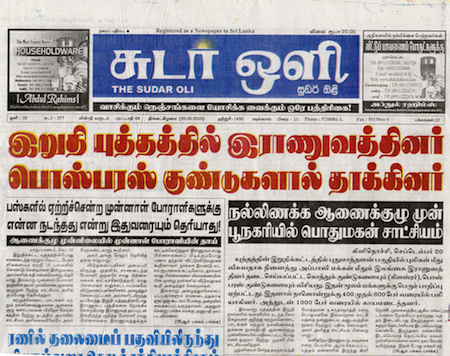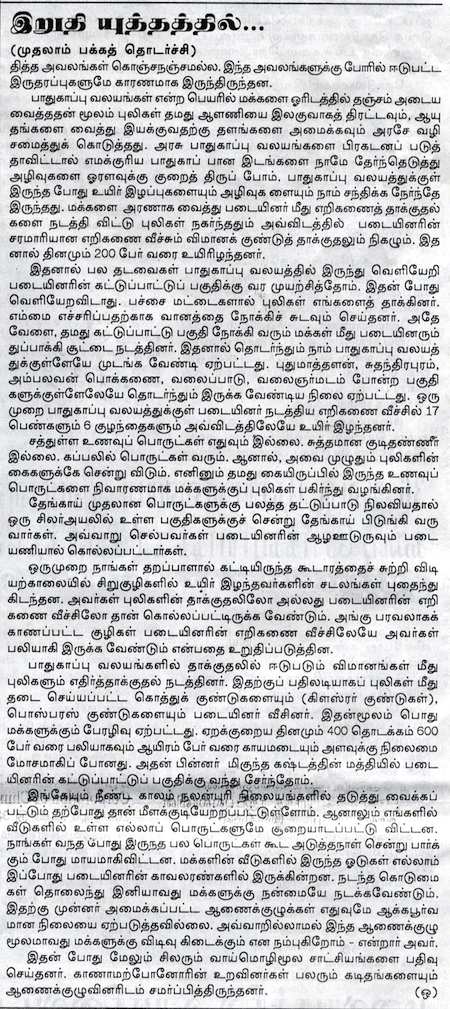The partial, unprofessional and biased mainstream media reportage, particularly in English and Sinhala, on on-going proceedings of the Lessons Learnt and Reconciliation Commission (LLRC) has been repeatedly flagged on this site.
On 20 September 2010, the Sudar Oli newspaper published a report based on the testimony of N. Sundermurthi to the LLRC. Not a single English or Sinhala mainstream print or broadcast media bothered to carry this story, even in translation. As Valkryie notes in ‘Learning Lessons’ from those affected by war: Does the Lessons Learnt and Reconciliation Commission really listen?
“The most recent sessions of the Lessons Learnt and Reconciliation Commission (LLRC) were held in the conflict affected North from 18 to 20 September, at which a large number of persons, particularly women, made representations. Of course one wouldn’t know it by reading the newspapers, listening to the radio or watching television. In what appears to be a complete information blackout, Sinhala and English language media, which gave considerable prominence to representations made by those appearing before the Commission in Colombo, such as Jayantha Dhanapala and Austin Fernando, were conspicuously silent when the LLRC held sittings in the area where the final battle between the Sri Lanka armed forces and the Liberation Tigers of Tamil Eelam (LTTE) was fought. In contrast, the Tamil newspapers carried heart wrenching accounts of mostly women who had lost, in many cases, their entire families.”
The Sudar Oli story is one example of such a heart-wrenching account of civilians trapped in war.


High resolution scans of the original story can be download from here (for front page) and here (for inner page continuation of story). Sinhala translation available on Vikalpa here.
The translation of the article follows. One has to wonder why the mainstream English and Sinhala media are not flagging vital narratives such as these, told in public to a ‘home-grown’ Presidential commission, by those who survived conditions few of us can scarce imagine the horror of.
###
Sudar Oli, 20 September 2010, Lead Story
Army uses phosphorus bombs in final war – Pooneryn inhabitants tell the Lessons Learnt and Reconciliation Commission (LLRC)
Killinochchi, 20 September:
In the final stages of the war, thinking they were attacking the LTTE around Puthumathalan, the Army used cluster bombs and phosphorus bombs against innocent civilians. There were many casualties on account of this. Around 400 – 600 died daily, and around 1,000 were injured.
A witness to atrocities in the final stages of the war testified in front of the Lessons Learnt and Reconciliation Commission (LLRC) in Pooneryn yesterday. Based on his experiences, N. Sundermurthi, an official from the Pooneryn Agriculture Development Authority went on to note in front of the LLRC that,
The so-called humanitarian war spread over Mannar, Killinochchi and Mulathivu. Since the war continued unabated, displacement of civilians was commonplace. The displacement that began in Mannar stretched to Mullivaikkal. The suffering of civilians during this period of time was immense. Both parties to the war are responsible for this. Because the government established so-called Safe Zones and placed civilians in them, the LTTE was able to recruit new cadre with ease and also store weaponry in them. If the government hadn’t established Safe Zones, we would have found safe zones ourselves and minimised casualties. When we were in the safe zones, we had to face life-threatening circumstances. Using civilians as a protective shield, the LTTE attacked the Army using shells and quickly moved out of the area, only to have the Army retaliate with shell and air attacks. On account of this, around 200 died daily.
On account of this, we tried several times to get out of the safe zones and into Army controlled areas. Whenever we tried, the LTTE didn’t allow us to move and attacked us with raw blades. They shot into the air to scare us. At the same time, the Army also shot civilians who attempted to move into areas under their control. Because of this, we stayed in the safe zone. Puthumathalan, Suthanthipuram, Ambalavan Pokkanai, Valaipadu and Valiyarmadam were some of the areas we stayed in. On one occasion, Army shelling into the safe zone killed 17 women and 6 children instantly.
There was no nutritious food in these areas. There was not even drinking water. There were supplies by ship, but they all went to the hands of the LTTE. From their stores and warehouses, the LTTE distributed food items to the civilians as rations.
Because there was a shortage of coconut, we were to neighbouring areas to pick them. Some who went in this manner were killed by the deep penetration units of the Army.
At one time, at dawn, we saw skeletons in holes in the earth around the tents. They had died either from LTTE or Army attacks. There were a lot of holes around, and it was evident that these people had died from Army shelling.
The LTTE even attacked airplanes that were sent to attack the safe zones. When they counter-attacked, the Army used banned phosphorus and cluster bombs against the LTTE. There were many casualties on account of this. Around 400 – 600 died daily, and around 1,000 were injured. It was a grim situation. After this, amidst incredible hardship, we arrived in areas controlled by the Army.
Even after this, it was only after we were kept for a long time in welfare camps that we were resettled. But every single item from our homes were looted. After we returned, the first goods we kept were stolen the next day. The tiles on the roofs of houses are now atop Army checkpoints. After all this calamity, something good must happen to these peoples. Earlier commissions that were appointed for this purpose were useless. We believe this commission will be different, and be beneficial to the peoples.
At this time, other people also gave testified in front of the commission. Relatives of those who had disappeared also gave letters to the commission.
